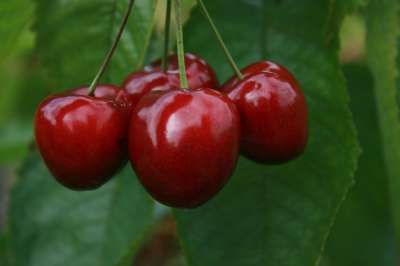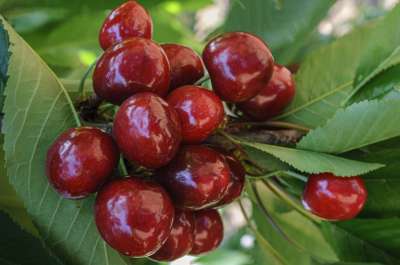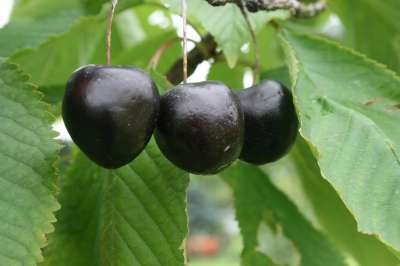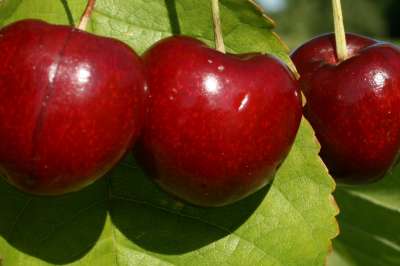Your basket is currently empty!
When it comes to choosing a cherry tree for your garden it pays to be very selective. There are quite a few older varieties which have their own charm and merits, but garden suitability often isn’t one of them. They can be unreliable and, more importantly, they mostly need a pollinator which then involves quite a lot of hassle trying to choose the right partners that go together, plus of course you need at least two trees. If you have some experience growing cherries, or have a large orchard to plant up, fine. Otherwise leave these to the experts.

Newer varieties of cherry often have that valuable self-pollinating attribute. This means they can grow and crop very well on their own so you only need one tree. If you want to plant a pair or more, that’s fine too – they will also cross fertilise to give you even better crops of delicious fruit and these varieties tend to have that extra dash of good nature and reliability. The fruits are frequently larger and more plentiful too. So this is why they are recommended above all others.
You might think choosing the right variety is the hardest part. It is important, but there are other important considerations as well, in regard to the type of tree and the way in which you grow it. Have a look at the product purchase options for cherry trees on our website and you will see what might at first seem a bewildering array of choices. Don’t be too daunted, what they really are is simply different ways of growing cherry trees. Your ultimate choice will depend on the available space and aspect that you have so often it comes down to just one choice and hopefully forearmed with the information in this article, you will make the one that is ideal for you. You should always afford the best position for your cherry tree as they do demand more sun and warmth than most other fruit trees. If you plant in a frost pocket, a shady corner or a colder aspect it isn’t likely to be very successful. But the fruits are so delicious and results so worthwhile when you get it right that it’s worth affording your new cherry tree a bit of added luxury!
Planting cherries against a wall
Lucky enough to have a good sunny south or west facing wall? Ideal for a sweet dessert cherry. Here you will need a fan trained tree. These ingenious flat shaped trees will need a space about 2 metres high and at least 2 metres wide. A wall is better than a fence because the latter needs constant upkeep and the branches of a cherry can be quite ‘heavy’ so a wall is really better. It must be south or west facing for the best results.
Cherry trees for a border
Todays smaller gardens often feel the need for your fruit trees to be grown amongst other plants and flowers. That’s fine as long as you choose smaller growing self supporting trees that don’t cast too much shade. There are two options here – the column type tree and the small bush tree on a rootstocks called Gisela 5. The column tree, as it suggests, is a straight up and down tree that doesn’t spread and casts no shade. It’s great for planting beneath, easy to pick, and the easiest of all to prune. These perfect little trees grow to 2 metres high and produce really nice large well ripened fruit because the sunshine can get all around the tree. A bush type tree on Gisela 5 stock is like a scaled down version of a proper orchard cherry tree, with a trunk and a bushy head. Again it will only grow to 2 metres in height, but will also need 2 metres spread as well. You can still plant beneath it as long as you keep the trunk clear of branches as it grows. Make sure the tree does not get too much competition from neighbouring plants, as this can encourage disease and in particular cherry blackfly.
Cherry trees in grassy areas and larger lawn
For this type of situation you need a tree that will grow some., so you can mow and walk beneath it. Here you need the Colt rootstock option. It will make a fine upstanding tree of 3 metres high or maybe a little more, depending on how much you prune. This stock is more tolerant of poorer soils and good for a more open situation. It is the heaviest cropping tree of all, but is more difficult to net against bird predation. Of course the smaller trees already described are quite easy to net when in full fruit.
Cherry trees for patio and container growing – smaller growing trees
Of course you will need a small growing tree for lifer in a pot, the column option is ideal and very easy to grow, of go for the Gisela 5 small rootstock. In either case a container of 15-20 litre capacity is perfect, and use a loam base compost rather than peat based. Never use top soil for trees in pots.
Varieties of cherry for colder or less promising areas
The cooking variety Morello is well known for it’s dash of added hardiness and can do well in less promising or colder localities. It is also self fertile and a useful tree to have with it’s bountiful crops well suited to pies, freezing, juices, preserves and the like.
Growing Cherries in the fruit cage
Cherries are often the number one choice of tree for a fruit cage because more than any other they will benefit from the added protection from bird predation. Most fruit cages are no more than 7’ in height so you will need to choose the Gisela stock option which will make a nice handy dwarf tree that you can keep from growing through the roof of your fruit cage. You can also grow the column tree option inside a fruit cage, or you could also fan train against one end. Remember to allow 2 metres in width and maybe just alittle less in height for a fan trained tree. It should be situated on the side that gets the most direct sun.
Varieties
Here is my pick of the best, most reliable cherry varieties, selected over many years of personal experience.
6] CELESTE CHERRY TREE
This variety has large dark red fruits ripening in mid July and has the advantage of being a naturally compact grower forming a short jointed tree well clothed in dark foliage. This can hide some of the ripening fruits; maybe a disadvantage when harvesting but also an advantage against marauding beaky friends.
5] SYLVIA CHERRY TREE
Beautiful and sumptuous near black fruits of very fine quality, hanging directly beneath the foliage. This has been proven to reduce the chance of splitting during wet summers. Ripens late July.
4] LAPINS CHERRY TREE
A well established variety also sometimes known as Cherokee with very good quality fruits, ripening to dark red/near black. Excellent flavour, later ripening than most maincrop varieties. Does very well on Gisela 5 stock.
3] SUMMER SUN CHERRY TREE
Already very popular as it ripens after the mainstay varieties thus providing a season extending harvest of luscious dark fruits. Excellent reliability and very prolific in blossom, a fine garden variety.
2] STELLA CHERRY TREE
Probably the most well known garden variety. The fruits are bright dark red and the flowers set very freely even during colder Springs. Quite upright in habit when young, the branches tend to spread as it gets older. Wonderful to see in blossom; American raised.
1] SUNBURST
My choice as the best garden Cherry tree, Sunburst has it all. Prolific, reliable, outstanding flavour and quality, the deepest red-black fruits ripening en masse in early July. Suits all growing applications. Outstanding.
Mention must also be made for ‘Stardust’ a new self fertile white cherry that has pretty white and rose pink blushed fruits with a white flesh and super-sweet flavour. The first self fertile white cherry. And for true late ripening qualities consider Kordia. It is not self fertile but partners well with any of the self fertile varieties mentioned above. It’s black fruits ripen in August, well after most other cherry trees, and it is a very good performer. Regina cherry tree is another new later ripening variety which, whilst not self fertile in itself, is easy to pollinate with any of the above. It is also probably the hardiest of the sweet cherries so maybe worth trying if you live in a cold area.
Further Notes
Extra water at the time when the fruits are beginning to swell is recommended, but try to water regularly rather than in a boom-or-bust manner because this can conversely lead to splitting of the fruits. Always water at the base of the tree. In years of over abundance thinning the fruits when the size of a small pea will reduce the risk of the fruits dropping before mature, and also the chance of biennial cropping. If the tree exhausts itself one summer it may decide to have a rest the next, although this is less of a trait with the newer varieties it is still possible.
After cropping treat your cherry tree kindly – still give it added water if the late summer climate is dry and give it a mulch and feed of growmore too, to build up it’s strength for next Spring.





